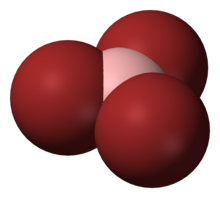
Back ثلاثي بروميد البورون Arabic تریبرومید بور AZB Bromid boritý Czech Bortribromid German Τριβρωμιούχο βόριο Greek تریبرمید بور Persian Booritribromidi Finnish Tribromure de bore French Tribromuro di boro Italian 三臭化ホウ素 Japanese

| |

| |
| Names | |
|---|---|
| IUPAC name
Boron tribromide
| |
| Other names
Tribromoborane, Boron bromide
| |
| Identifiers | |
3D model (JSmol)
|
|
| ChemSpider | |
| ECHA InfoCard | 100.030.585 |
| EC Number |
|
PubChem CID
|
|
| RTECS number |
|
| UNII | |
| UN number | 2692 |
CompTox Dashboard (EPA)
|
|
| |
| |
| Properties | |
| BBr3 | |
| Molar mass | 250.52 g·mol−1 |
| Appearance | Colorless to amber liquid |
| Odor | Sharp and irritating[1] |
| Density | 2.643 g/cm3 |
| Melting point | −46.3 °C (−51.3 °F; 226.8 K) |
| Boiling point | 91.3 °C (196.3 °F; 364.4 K) |
| Reacts violently with water and other protic solvents | |
| Solubility | Soluble in CH2Cl2, CCl4 |
| Vapor pressure | 7.2 kPa (20 °C) |
Refractive index (nD)
|
1.00207 |
| Viscosity | 7.31 x 10−4 Pa s (20 °C) |
| Thermochemistry | |
Heat capacity (C)
|
0.2706 J/K |
Std molar
entropy (S⦵298) |
228 J/mol K |
Std enthalpy of
formation (ΔfH⦵298) |
-0.8207 kJ/g |
| Hazards | |
| Occupational safety and health (OHS/OSH): | |
Main hazards
|
Reacts violently with water, potassium, sodium, and alcohols; attacks metals, wood, and rubber[1] |
| GHS labelling: | |
 
| |
| Danger | |
| H300, H314, H330 Within the European Union, the following additional hazard statement (EUH014) must also be displayed on labeling: Reacts violently with water. | |
| NFPA 704 (fire diamond) | |
| Flash point | Noncombustible[1] |
| NIOSH (US health exposure limits): | |
PEL (Permissible)
|
None[1] |
REL (Recommended)
|
C 1 ppm (10 mg/m3)[1] |
IDLH (Immediate danger)
|
N.D.[1] |
| Safety data sheet (SDS) | ICSC 0230 |
| Related compounds | |
Related compounds
|
Boron trifluoride Boron trichloride Boron triiodide |
Except where otherwise noted, data are given for materials in their standard state (at 25 °C [77 °F], 100 kPa).
| |
Boron tribromide, BBr3, is a colorless, fuming liquid compound containing boron and bromine. Commercial samples usually are amber to red/brown, due to weak bromine contamination. It is decomposed by water and alcohols.[2]
- ^ a b c d e f NIOSH Pocket Guide to Chemical Hazards. "#0061". National Institute for Occupational Safety and Health (NIOSH).
- ^ "Boron Tribromide". Toxicologic Review of Selected Chemicals. National Institute for Occupational Safety and Health. 2018-09-21.
